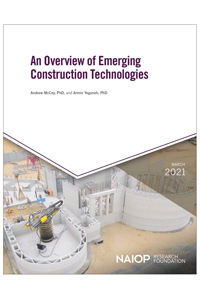Innovation Brings Change to Commercial Construction

New technologies promise higher quality, faster timelines, lower costs.
Commercial construction has lagged other major industries in technological change for a variety of reasons. Design requirements and site conditions are usually particular to an individual project, making economies of scale difficult to achieve. The industry is composed of many smaller firms encompassing a range of professions and specializations, complicating the adoption of new technologies. Smaller firms often lack budgets that would allow for significant investments in new equipment.
These and other factors have limited the productivity growth that other major industries have generated from technological innovation. Commercial construction remains a labor-intensive industry, but in recent years it has faced a persistent and growing labor shortage, leading to rising costs for contractors and developers.
Fortunately, recent advances have enabled a new generation of more efficient, flexible and adaptable construction technologies, with a range of applications including design, quality control, risk mitigation, site monitoring and project management. The NAIOP Research Foundation has published a new report titled “An Overview of Emerging Construction Technologies” by Andrew McCoy, Ph.D., and Armin Yeganeh, Ph.D., that explores these advances. The report draws from interviews with researchers and industry practitioners to profile key emerging construction technologies and examine their implications for the commercial construction industry.
Familiar Technologies on Construction Sites
The report includes an evaluation of emerging technologies that are increasingly common in commercial construction. Many of these can be used in most commercial projects. For example, geospatial technologies, like geographic information systems and satellite remote sensing, can facilitate site surveying and risk mitigation for most project types. Wearable sensors can help project managers track worker locations and limit their exposure to workplace hazards across different construction sites. This type of broad applicability has led most construction practitioners to employ one or more emerging technologies in their projects. The report reveals that many newer technologies present relatively low barriers to adoption and can be incrementally integrated into existing construction practices.
Other emerging technologies, such as modular construction, require more significant changes to the way projects are organized, but are nonetheless becoming more common due to their potential benefits. For example, modular construction makes extensive use of prefabrication, lowering material and onsite labor costs and shortening project timelines, but it requires substantial changes to the planning and execution of projects. These include additional investments in design and advanced planning for the procurement, transportation and installation of modular components. It is currently most cost-effective for projects that can be scaled using repeated forms, such as multifamily or hospitality projects.
Technologies on the Horizon
A range of emerging technologies, from additive manufacturing to mass timber and autonomous construction vehicles, have only been implemented in a limited number of commercial projects, but McCoy and Yeganeh believe their full potential has not yet been realized. Some technologies will likely become more widespread as their capabilities expand. For example, construction robots and autonomous construction vehicles currently have a limited range of applications because most are constrained to specific tasks or a specific operating environment. Advances in artificial intelligence, sensors and communications technologies should allow robots and autonomous vehicles to perform a wider range of tasks in more complex and dynamic environments.
The widespread adoption of other technologies, like mass timber, will be more dependent on changes across the construction industry. Firms that are interested in working with cross-laminated timber (CLT) need to adapt their design and construction processes to incorporate the material, and they currently have access to a limited range of CLT suppliers. There is room for improvement in mechanical connections for CLT, and firms have only begun to erect taller mass timber buildings. As more mass timber projects are completed, orders grow for CLT components and more firms become familiar with the material, the cost of using mass timber relative to conventional construction materials should decline.
Firms can expect that other emerging technologies will follow a similar arc: as a technology becomes more common, incremental costs to adopt the technology will decline and it can be applied to a broader range of projects. However, as the report reveals, the adoption of even low-cost technologies may require substantial changes in how firms organize projects and recruit and train personnel. Developers, contractors and others engaged in commercial construction can refer to the report to evaluate the benefits and limitations of individual technologies and prepare their organizations for technological change.
Shawn Moura, Ph.D., is the director of research for NAIOP.
Get the Report

To view and download “An Overview of Emerging Construction Technologies,” visit www.naiop.org/en/Research-and-Publications/Research-Reports




